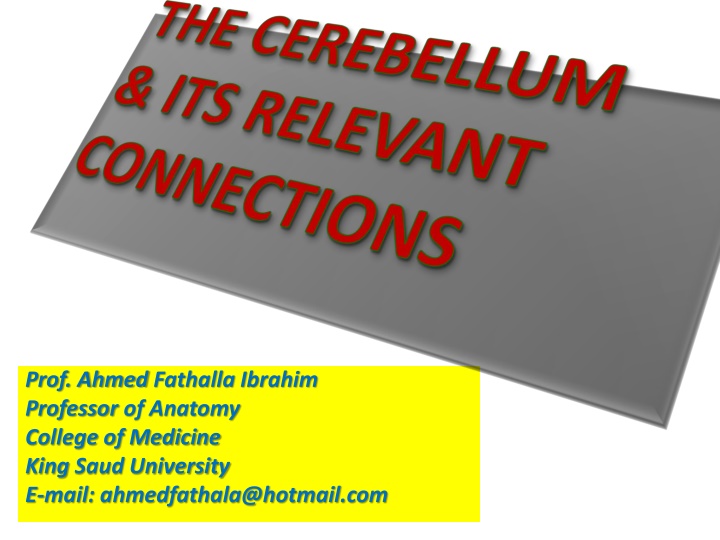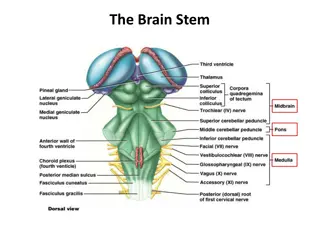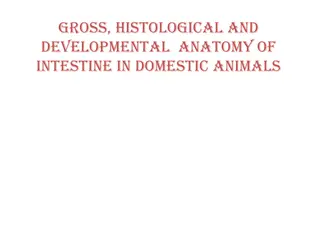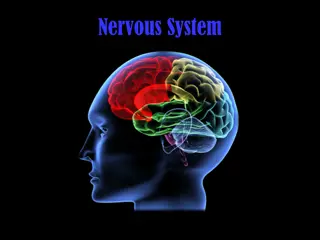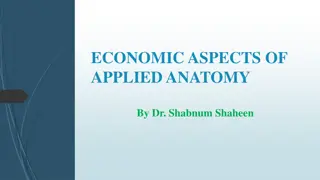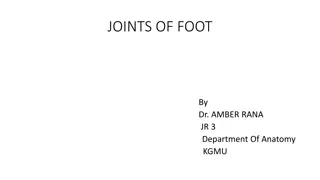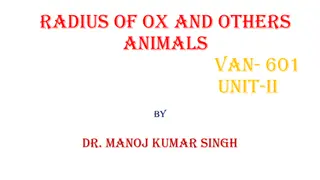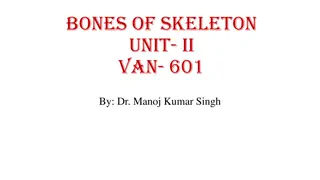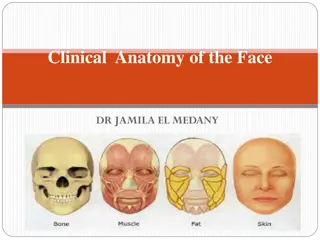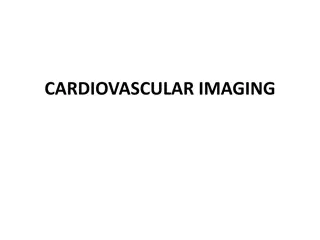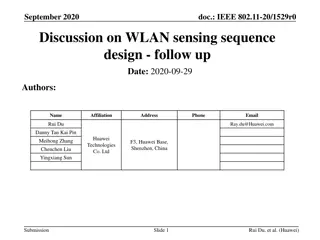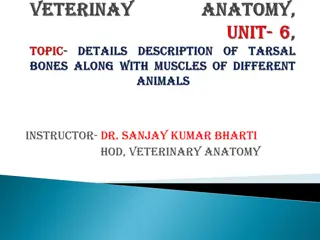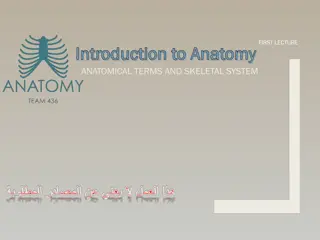Anatomy of the Cerebellum: Structure and Function
The external features, internal structure, anatomical subdivisions, and constituents of the cerebellum. Learn about its connections to the brain stem, effects of lesions, and more.
Download Presentation

Please find below an Image/Link to download the presentation.
The content on the website is provided AS IS for your information and personal use only. It may not be sold, licensed, or shared on other websites without obtaining consent from the author.If you encounter any issues during the download, it is possible that the publisher has removed the file from their server.
You are allowed to download the files provided on this website for personal or commercial use, subject to the condition that they are used lawfully. All files are the property of their respective owners.
The content on the website is provided AS IS for your information and personal use only. It may not be sold, licensed, or shared on other websites without obtaining consent from the author.
E N D
Presentation Transcript
Prof. Ahmed Fathalla Ibrahim Professor of Anatomy College of Medicine King Saud University E-mail: ahmedfathala@hotmail.com
OBJECTIVES At the end of the lecture, students should: Describe the external features of the cerebellum (lobes, fissures). Describe briefly the internal structure of the cerebellum. List the name of cerebellar nuclei. Relate the anatomical to the functional subdivisions of the cerebellum. Describe the important connections of each subdivision. Describe briefly the main effects in case of lesion of the cerebellum.
THE CEREBELLUM ORIGIN: from hindbrain, separated from pons & medulla by fourth ventricle. CONNECTION TO BRAIN STEM: by inferior, middle & superior cerebellar peduncles.
EXTERNAL FEATURES It consists of two cerebellar hemispheres joined in midline by the vermis. Its surface is highly convoluted forming folia separated by fissures.
ANATOMICAL SUBDIVISION 1. 2. 3. Anterior lobe: in front of primary fissure Posterior (middle) lobe: behind primary fissure Flocculonodular lobe.
CONSTITUENTS 1. 2. 3. Outer grey matter: cerebellar cortex. Inner white matter: cerebellar medulla. Deeply seated nuclei in white matter: from medial to lateral: Fastigeal nucleus: smallest one. Globose nucleus. Emboliform nucleus. Dentate nucleus: largest one.
CEREBELLAR CORTEX Divided into 3 layers: 1. Outer molecular layer 2. Intermediate Purkinje cell layer 3. Inner granular layer
CEREBELLAR MEDULLA AFFERENT FIBRES: Climbing fibres: from inferior olivary nucleus, relay to purkinge cells Mossy fibres: rest of fibres: 1. From vestibular nuclei 2. From spinal cord 3. From pons They relay to granule cells which in turn relay to purkinge cells
CEREBELLAR MEDULLA Axons of purkinge cells are the only axons to leave the cortex to medulla: 1. The great majority of axons do not leave cerebellum & end in deep cerebellar nuclei. 2. Some of axons leave cerebellum as efferent fibres.
CEREBELLAR MEDULLA EFFERENT FIBRES: Most of efferent fibres are axons of deep cerebellar nuclei. Main efferents go to: 1. Vestibular nuclei 2. Red nucleus 3. Ventral lateral nucleus of thalamus
FUNCTIONAL SUBDIVISIONS OF THE CEREBELLUM
ARCHICEREBELLUM Purkinge cells of flocculonodular lobe Fastigeal nucleus BALANCE ICP ICP Vestibular nuclei
ARCHICEREBELLUM Part of cerebellum: flocculonodular lobe Nuclei: fastigeal Afferents: from vestibular nuclei (through ICP) Efferents: to vestibular nuclei (through ICP) Function: controls balance
PALEOCEREBELLUM Purkinge cells of vermis & paravermis ICP Globose & emboliform nuclei POSTURE & MUSCLE TONE SCP SCP Red nucleus Spinal cord
PALEOCEREBELLUM Part of cerebellum: vermis & paravermis Nuclei: globose & emboliform Afferents: from spinal cord (dorsal & ventral spinocerebellar tracts through ICP & SCP, respectively) Efferents: to red nucleus (through SCP) Function: influences posture & muscle tone
NEOCEREBELLUM Purkinge cells of rest of cerebellum Dentate nucleus MCP Red nucleus & Ventral lateral nucleus of thalamus COORDINATION OF VOLUNTARY MOVEMENTS Pons Motor cortex
NEOCEREBELLUM Part of cerebellum: rest of cerebellum Nuclei: dentate Afferents: from pons (through MCP) Efferents: to red nucleus but mostly to ventral lateral nucleus of thalamus (through SCP) then to motor cortex Function: coordination of voluntary movements
CEREBELLAR LESIONS MIDLINE LESION: Loss of postural control UNILATERAL LESION: Cerebellar ataxia causes ipsilateral: 1. Incoordination of arm: intention tremor (on performing voluntary movements) 2. Incoordination of leg: unsteady gait 3. Incoordination of eye movements: nystagmus 4. Slowness of speech: dysarthria
SUMMARY Anatomically, the cerebellum is divided into: anterior, posterior & flocculonodular lobes. Developmentally & functionally, it is divided into: archi- paleo- & neocerebellum. Archicerebellum (flocculonodular lobe) is the oldest part of cerebellum, related to fastigeal nucleus, connected to vestibular nuclei & concerning for control of body balance.
SUMMARY Paleocerebellum (vermis & paravermis) is related to globose & emboliform nucleus, connected to spinal cord & red nucleus & concerning for regulation of posture & muscle tone. Neocerebellum (most of human cerebellum) is related to dentate nucleus, connected to pons, thalamus. Its final destination is to motor cortex. It is concerned with coordination of voluntary movements. Cerebellar lesions lead to ipsilateral incoordination (ataxia).
QUESTION 1 Which one of the following nucleus is related to archicerebellum? 1. Fastigeal nucleus 2. Dentate nucleus 3. Globose nucleus 4. Emboliform nucleus
QUESTION 2 To which part of the CNS the flocculonodular lobe send its efferent fibers? 1. Red nucleus 2. Pons 3. Vestibular nuclei 4. Motor cortex
THANK YOU THANK YOU
